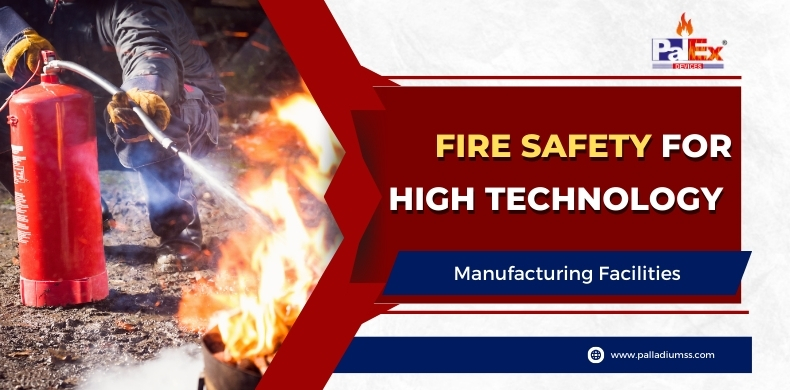In the field of high technology production, where novelty and accuracy are the main factors, fire protection is frequently less important than worries about creating things. Nevertheless, the special difficulties raised by these facilities make fire safety not just essential but crucially vital. Ranging from cleanrooms to locations for storing chemicals, facilities for high-tech manufacturing can be seen as a complicated environment of fire dangers that necessitate equally intricate safety procedures.
The Unique Fire Risks in High-Tech Manufacturing
Fire threats in high technology manufacturing locations are not the same as those seen in regular industrial settings. Numerous operations use extremely inflammable or reactive chemicals, which can cause fire to spread quickly. Expensive and sensitive machinery could be harmed by both fire and usual suppressing methods.
In some manufacturing processes, the controlled atmospheres needed make detecting and stopping fires more difficult. High-energy tools such as lasers or plasma cutters bring specific dangers of starting a fire. Moreover, continuous production that goes on all day and every day can cause equipment to get too hot and heighten fire danger because there is no time for maintenance breaks.
Risk Assessment and Planning
Fire safety starts with a complete understanding of the risks involved. This means finding all possible fire dangers, thinking about how likely and serious different fire situations could be, and making a detailed plan for safety from fire. If your place is a high-tech facility, then this assessment should be very thorough. You need to consider the exact processes, materials and equipment being used. It must also think about the risk of business disruption, because in delicate manufacturing settings even a minor fire can cause considerable time off.
Advanced Detection Systems
In high-tech manufacturing spaces, fires can spread fast. Using only traditional smoke detectors might not work well or be enough for some areas. Think about using different types of detection technologies together: aspirating smoke detectors give early warning in cleanrooms and places with lots of airflow, and gas detection systems to notify staff when there’s a dangerous amount of flammable or poisonous gas before it becomes too much.
Specialized Suppression Systems
Although water-based sprinkler systems are commonly used and dependable in numerous locations, they might lead to permanent harm for delicate equipment and materials found in high-tech production facilities. The decision on what kind of suppression system needs to be installed should depend on the particular risks and needs of each location within the facility.
Compartmentalization and Containment
To restrict the movement of fire and smoke, fire containment methods are crucial. These consist of having fire-rated walls and doors in between various manufacturing sections, automated fire doors and shutters, correctly sealed cable or pipe penetrations, as well as smoke control systems that keep evacuation routes clear.
Emergency Response Planning
A team that has been taught well is the initial defense against fire. Make and frequently run through emergency reaction steps, such as escape plans adjusted to the building’s design, training for handling fire extinguishers and other manual firefighting tools, clear rules on how to close down important operations safely during a fire incident, as well as regular practice sessions to confirm all personnel comprehend their duties in an urgent situation.
Maintenance and Inspection
The advanced fire safety systems in high-tech places need careful upkeep to guarantee they work properly when necessary. Put into operation a thorough examination and maintenance timetable for all fire safety gear, which will include frequent experimentation of identification and suppression systems, inspection of fire doors as well as other passive protection against fires measures like emergency lighting & signage checking, confirmation on the cleanliness room environment integrity along with its safeguarding from fires features.
Also read : Safeguarding India’s High-Risk Industries with Unparalleled Fire Safety Solutions
Compliance and Documentation
Keep track of changes in fire safety rules and norms. Make sure to have records for all fire safety actions, checks, and happenings. This is not just important for following the law, it might also become very necessary if there’s an insurance claim or investigation.
Integration with Production Processes
Fire safety is not a detached aspect from production but rather an integrated element in it. Whenever you bring about new manufacturing methods or tools, always think of the implications for fire safety and make necessary adjustments to protection measures.
The Role of Technology in Modern Fire Safety
Fire safety in high-tech manufacturing environments is benefiting from new technology tools. For example, Internet of Things (IoT) sensors can give real-time monitoring for risks of fire. Systems powered by Artificial Intelligence (AI) are able to analyze data from various sources, which helps in predicting and stopping fire incidents. Virtual reality, together with other advanced technologies, can improve the quality of fire safety training. We should adopt these methods to make our fire prevention strategies more proactive and efficient.
Bottom Line
Handling fire safety in high technology manufacturing facilities is a special task that needs creative solutions. If we apply a complete plan which has modern methods for detecting and stopping fires, careful preparation, frequent practice, plus using contemporary technology effectively – these places can greatly lower their danger from fires.



